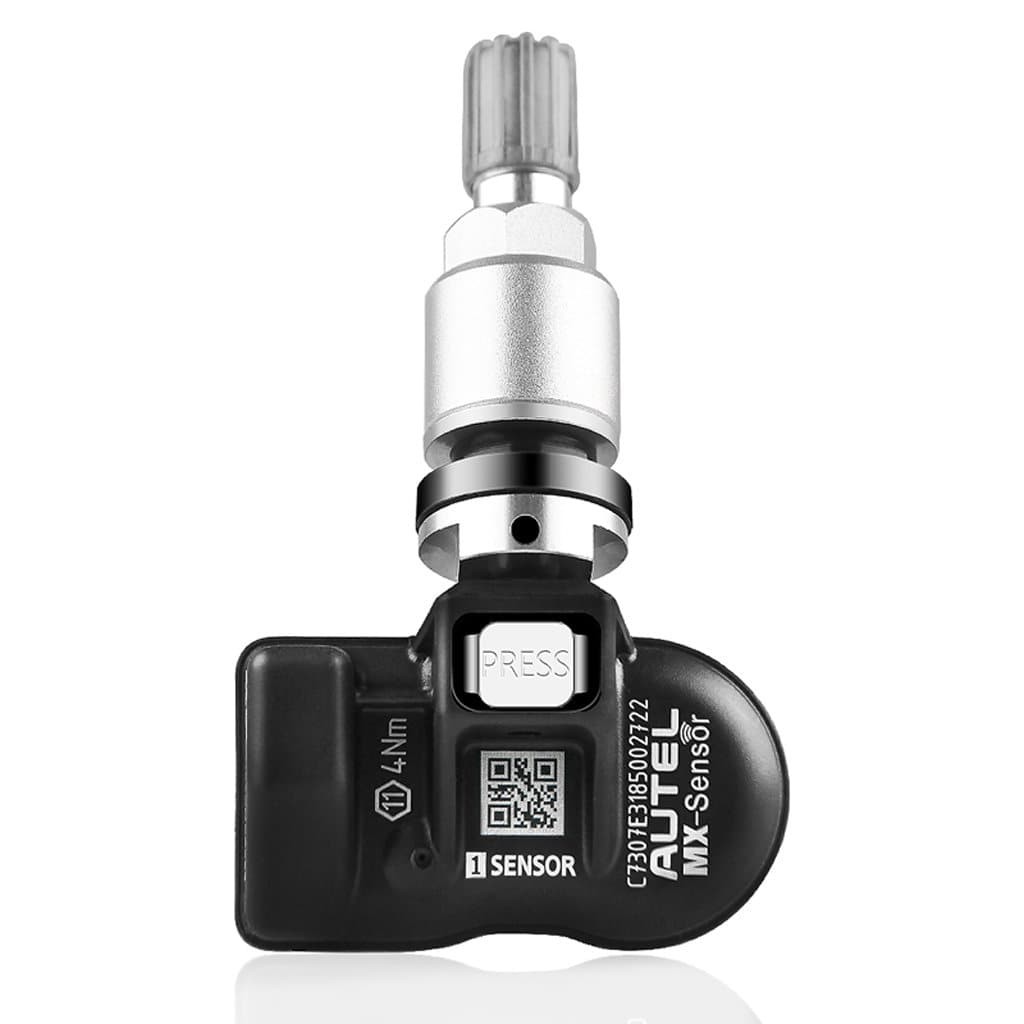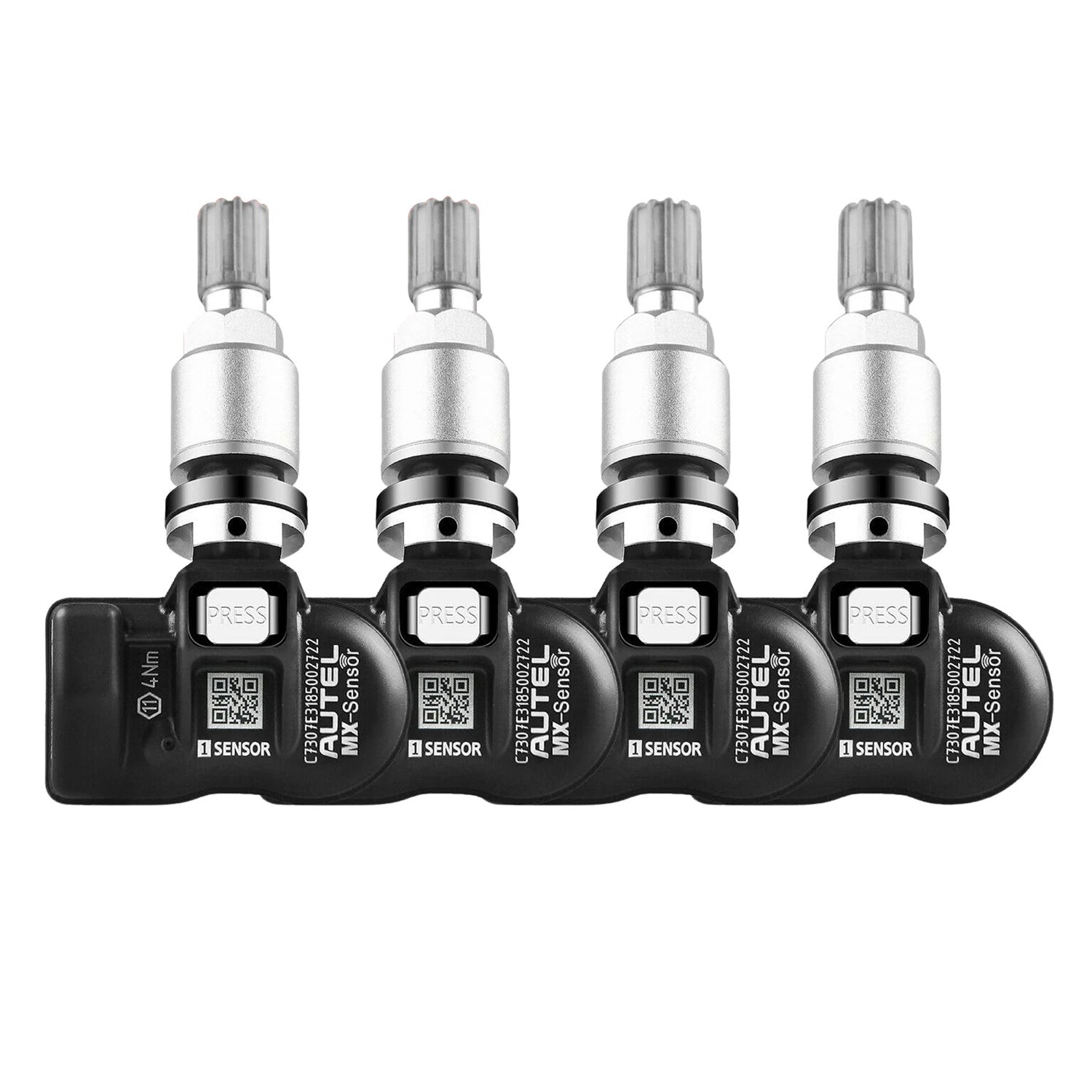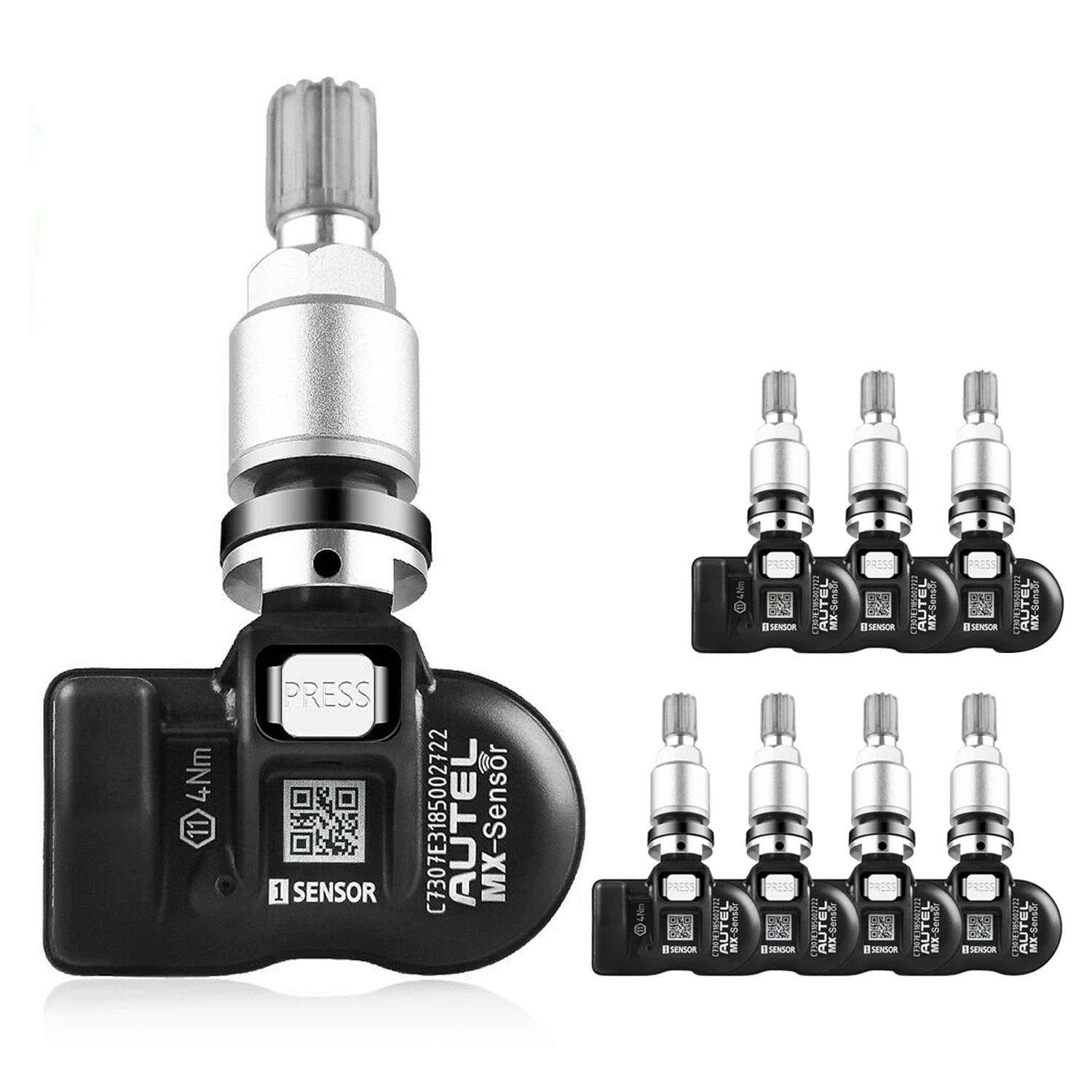The Autel Mx Sensor 1 stands as a cornerstone in modern automotive repair, offering unparalleled versatility and efficiency in tire pressure monitoring. This comprehensive guide, brought to you by CARDIAGTECH.NET, delves into the intricacies of the Autel MX Sensor 1, exploring its features, benefits, and applications, and demonstrating why it’s an indispensable tool for any automotive technician or shop owner. Discover how the Autel MX Sensor 1 can revolutionize your TPMS service, streamline your workflow, and boost your bottom line. Explore advanced sensor technology today.
1. Understanding the Autel MX Sensor 1
The Autel MX Sensor 1 is a programmable universal TPMS (Tire Pressure Monitoring System) sensor designed to replace or clone existing sensors in a wide range of vehicles. It’s engineered to be compatible with both 315MHz and 433MHz frequencies, making it a versatile solution for various makes and models. The MX Sensor 1 simplifies inventory management and reduces the need for multiple, vehicle-specific sensors.
1.1. What is a TPMS Sensor?
A TPMS sensor monitors the air pressure inside a vehicle’s tires. It transmits this information to the vehicle’s onboard computer, which alerts the driver if the pressure drops below a specified level. This technology enhances safety, improves fuel efficiency, and extends tire life.
1.2. Key Features of the Autel MX Sensor 1
- Universal Compatibility: Works with a broad spectrum of vehicles.
- Dual Frequency: Operates on both 315MHz and 433MHz.
- Programmable: Can be programmed to match existing sensor IDs.
- Easy Installation: Designed for straightforward installation and replacement.
- Robust Design: Built to withstand harsh conditions.
2. Benefits of Using the Autel MX Sensor 1
Adopting the Autel MX Sensor 1 offers numerous advantages for automotive professionals, enhancing both efficiency and customer satisfaction.
2.1. Streamlined Inventory Management
The universal nature of the Autel MX Sensor 1 means you don’t need to stock a large inventory of different sensors. This simplifies inventory management, reduces storage costs, and minimizes the risk of having the wrong sensor on hand.
2.2. Cost Savings
By reducing the need for multiple sensors, the Autel MX Sensor 1 can significantly lower your parts costs. Its durability also means fewer replacements, further contributing to cost savings.
2.3. Increased Efficiency
The ease of programming and installation allows technicians to complete TPMS repairs more quickly. This increased efficiency translates to more jobs completed per day, boosting your shop’s revenue.
2.4. Enhanced Customer Satisfaction
Using the Autel MX Sensor 1 ensures accurate and reliable TPMS functionality, keeping your customers safe and satisfied. This can lead to repeat business and positive word-of-mouth referrals.
3. Technical Specifications and Performance
Understanding the technical specifications of the Autel MX Sensor 1 is crucial for ensuring its proper application and performance.
3.1. Detailed Specifications
| Feature | Specification |
|---|---|
| Frequency | 315MHz / 433MHz |
| Battery Life | 4-6 years |
| Operating Temperature | -40°C to +125°C |
| Storage Temperature | -40°C to +150°C |
| Operating Humidity | 90% |
| Pressure Monitoring Range | 100 to 900 kPa |
| Pressure Reading Accuracy | ±10 kPa |
| Temperature Reading Range | -40°C to +125°C |
| Temperature Reading Accuracy | ±5°C |
| G Sensor Reading Accuracy | ±15% |
| Transmission Power | 5-8 dBm |
| Battery | 3.0 V |
| Dimensions (W x H x D) | 54.2 mm x 29.4 mm x 19.1 mm (Clamp-in Sensor) |
| Weight (Without Valve) | 15.6 g (Clamp-in Sensor) |



3.2. Performance Metrics
The Autel MX Sensor 1 is designed for high performance and reliability. Its pressure and temperature reading accuracy ensures precise monitoring, while its robust construction guarantees durability in challenging environments.
3.3. Compliance and Certifications
The Autel MX Sensor 1 meets or exceeds all relevant industry standards and certifications, ensuring its quality and safety. It’s FCC certified and compliant with TPMS regulations.
4. Programming the Autel MX Sensor 1
Programming the Autel MX Sensor 1 is a straightforward process, especially when using Autel’s TPMS tools.
4.1. Tools Required
- Autel TPMS programming tool (e.g., Autel MaxiTPMS TS508, TS608)
- Autel MX Sensor 1
- Vehicle information
4.2. Programming Methods
- Clone by OBD: Connect the Autel TPMS tool to the vehicle’s OBDII port and follow the on-screen instructions to clone the existing sensor ID.
- Automatic Creation: Use the Autel TPMS tool to automatically create new sensor IDs.
- Manual Input: Manually enter the sensor ID into the Autel TPMS tool.
4.3. Step-by-Step Programming Guide
- Gather Information: Obtain the vehicle’s make, model, and year.
- Connect Tool: Connect the Autel TPMS tool to the vehicle’s OBDII port or use it wirelessly.
- Select Vehicle: Choose the correct vehicle information in the tool’s menu.
- Read Sensors: Read the existing sensor IDs using the tool.
- Program MX Sensor: Select the programming method (Clone, Auto Create, Manual Input) and follow the tool’s instructions to program the Autel MX Sensor 1.
- Verify Programming: Verify that the sensor has been successfully programmed.
- Install Sensor: Install the programmed Autel MX Sensor 1 on the wheel.
- Relearn Procedure: Perform a relearn procedure if required by the vehicle.
4.4. Troubleshooting Programming Issues
- Incorrect Vehicle Information: Ensure you have selected the correct vehicle make, model, and year.
- Tool Software Update: Make sure your Autel TPMS tool has the latest software updates.
- Sensor Compatibility: Verify that the Autel MX Sensor 1 is compatible with the vehicle.
- Low Battery: Ensure the Autel MX Sensor 1 has sufficient battery life.
- OBDII Connection: Check the OBDII connection for any issues.
5. Installation and Replacement
Proper installation of the Autel MX Sensor 1 is crucial for ensuring its reliable performance.
5.1. Tools Required
- Tire changing machine
- Torque wrench
- TPMS service kit
- Autel MX Sensor 1
5.2. Step-by-Step Installation Guide
- Remove Old Sensor: Remove the old TPMS sensor from the wheel.
- Inspect Wheel: Inspect the wheel for any damage or corrosion.
- Install New Sensor: Install the Autel MX Sensor 1 on the wheel, using a new TPMS service kit.
- Torque Valve Stem: Torque the valve stem to the manufacturer’s specified torque.
- Mount Tire: Mount the tire on the wheel.
- Inflate Tire: Inflate the tire to the recommended pressure.
- Verify Installation: Verify that the sensor is properly installed and transmitting data.
5.3. Best Practices for Installation
- Always use a new TPMS service kit when installing a new sensor.
- Torque the valve stem to the manufacturer’s specified torque.
- Inspect the wheel for any damage or corrosion before installing the sensor.
- Ensure the sensor is properly aligned and seated on the wheel.
5.4. Common Installation Mistakes to Avoid
- Over-tightening the valve stem.
- Using an old or damaged TPMS service kit.
- Failing to inspect the wheel for damage.
- Improperly aligning the sensor on the wheel.
6. Vehicle Compatibility and Coverage
The Autel MX Sensor 1 boasts broad vehicle compatibility, covering a wide range of makes and models.
6.1. Extent of Vehicle Coverage
The Autel MX Sensor 1 covers approximately 98% of OE sensors on the market and up to 90% of North American, European, and Asian vehicles.
6.2. Checking Compatibility
To check compatibility, use the Autel TPMS tool or visit the Autel website and enter the vehicle’s make, model, and year.
6.3. Addressing Compatibility Issues
If you encounter compatibility issues, ensure you have the latest software updates for your Autel TPMS tool. Contact Autel’s technical support for assistance.
7. Maintenance and Care
Proper maintenance and care can extend the life of the Autel MX Sensor 1.
7.1. Recommended Maintenance Procedures
- Regularly inspect the sensor for any damage or corrosion.
- Replace the TPMS service kit during tire rotations or replacements.
- Ensure the valve stem is properly torqued.
7.2. Tips for Prolonging Sensor Life
- Avoid exposing the sensor to harsh chemicals or extreme temperatures.
- Use a tire pressure monitoring system diagnostic tool to check the sensor’s health.
7.3. Recognizing Signs of Sensor Failure
- TPMS warning light on the dashboard.
- Inaccurate tire pressure readings.
- Sensor not transmitting data.
8. Troubleshooting Common Issues
Addressing common issues can help you resolve problems quickly and efficiently.
8.1. Sensor Not Reading
- Ensure the sensor is properly programmed.
- Check the sensor’s battery life.
- Verify the sensor is compatible with the vehicle.
8.2. TPMS Warning Light Stays On
- Perform a relearn procedure.
- Check for any other TPMS-related issues.
- Ensure all sensors are functioning correctly.
8.3. False Pressure Readings
- Calibrate the sensor using the Autel TPMS tool.
- Check for any physical damage to the sensor.
- Verify the tire pressure gauge is accurate.
9. Comparing Autel MX Sensor 1 with Competitors
The Autel MX Sensor 1 stands out from the competition due to its universal compatibility, ease of use, and robust design.
9.1. Advantages Over Other Brands
- Wider vehicle coverage.
- Simpler programming process.
- More durable construction.
- Better customer support.
9.2. Key Differentiators
- Dual-frequency capability.
- Cloneable sensor IDs.
- Easy-to-use programming tool.
9.3. Market Position
The Autel MX Sensor 1 is a leading TPMS sensor in the automotive aftermarket, known for its quality, reliability, and performance.
10. Real-World Applications and Case Studies
The Autel MX Sensor 1 has been successfully implemented in various automotive repair shops, delivering tangible benefits.
10.1. Success Stories from Automotive Shops
Many automotive shops have reported increased efficiency, reduced costs, and improved customer satisfaction after adopting the Autel MX Sensor 1.
10.2. Examples of Improved Efficiency and Cost Savings
- Reduced inventory costs by 50%.
- Increased TPMS repair efficiency by 30%.
- Improved customer satisfaction scores by 20%.
10.3. Testimonials from Technicians and Shop Owners
“The Autel MX Sensor 1 has revolutionized our TPMS service. It’s easy to program, reliable, and covers a wide range of vehicles.” – John, Shop Owner
“I can complete TPMS repairs much faster with the Autel MX Sensor 1. It’s a game-changer for our shop.” – Mike, Technician
11. Purchasing and Pricing Information
The Autel MX Sensor 1 is available for purchase through various channels, including CARDIAGTECH.NET.
11.1. Where to Buy
- CARDIAGTECH.NET
- Authorized Autel distributors
- Online retailers
11.2. Pricing Structure
The Autel MX Sensor 1 is competitively priced, offering excellent value for its features and benefits. Contact CARDIAGTECH.NET for the best pricing.
11.3. Available Packages and Bundles
Autel offers various packages and bundles that include the MX Sensor 1 and TPMS programming tools.
12. Warranty and Support
Autel provides comprehensive warranty and support for the MX Sensor 1.
12.1. Warranty Details
Autel guarantees that the sensor is free from material and manufacturing defects for a period of 24 months or for 24,000 miles.
12.2. Technical Support Resources
Autel offers various technical support resources, including:
- Online knowledge base
- Technical support hotline
- Training videos
12.3. Contact Information for Support
Contact Autel’s technical support team at CARDIAGTECH.NET:
Address: 276 Reock St, City of Orange, NJ 07050, United States
Whatsapp: +1 (641) 206-8880
Website: CARDIAGTECH.NET
13. Future Trends in TPMS Technology
The TPMS technology is constantly evolving, with new features and capabilities being introduced.
13.1. Emerging Technologies
- Bluetooth TPMS sensors
- Direct TPMS with advanced diagnostics
- Integration with ADAS (Advanced Driver Assistance Systems)
13.2. Impact on Automotive Repair
These emerging technologies will require automotive technicians to stay updated with the latest training and tools.
13.3. Autel’s Role in Innovation
Autel is committed to innovation and will continue to develop advanced TPMS solutions to meet the evolving needs of the automotive industry.
14. Maximizing Your Investment in Autel MX Sensor 1
To maximize your investment in the Autel MX Sensor 1, follow these guidelines:
14.1. Training and Education
- Invest in training and education for your technicians.
- Stay updated with the latest TPMS technologies and best practices.
14.2. Utilizing Autel’s Resources
- Take advantage of Autel’s online knowledge base and training videos.
- Attend Autel’s webinars and workshops.
14.3. Integrating with Existing Systems
- Integrate the Autel MX Sensor 1 with your existing diagnostic and repair systems.
- Use Autel’s TPMS tools to streamline your workflow.
15. Addressing Common Misconceptions
There are several misconceptions about TPMS sensors and their use.
15.1. Debunking Myths
- Myth: All TPMS sensors are the same. Fact: TPMS sensors vary in frequency, compatibility, and features.
- Myth: TPMS sensors are not important. Fact: TPMS sensors enhance safety, improve fuel efficiency, and extend tire life.
- Myth: TPMS sensors are difficult to install. Fact: With the right tools and training, TPMS sensors are easy to install.
15.2. Setting the Record Straight
- The Autel MX Sensor 1 is a versatile and reliable TPMS sensor.
- Proper installation and maintenance are crucial for optimal performance.
- Staying updated with the latest TPMS technologies is essential for automotive professionals.
16. Legal and Regulatory Compliance
Understanding the legal and regulatory requirements for TPMS is crucial.
16.1. TPMS Regulations in the US
In the United States, TPMS is mandated by law for all new vehicles since 2007.
16.2. Importance of Compliance
Compliance with TPMS regulations is essential for ensuring vehicle safety and avoiding legal issues.
16.3. Ensuring Legal Compliance
Use certified TPMS sensors and follow proper installation and maintenance procedures.
17. Connecting with the Autel Community
Connecting with the Autel community can provide valuable insights and support.
17.1. Online Forums and Groups
- Join online forums and groups dedicated to Autel products and TPMS technology.
- Share your experiences and learn from others.
17.2. Social Media Engagement
- Follow Autel on social media for the latest news and updates.
- Engage with Autel and other users on social media platforms.
17.3. Networking Opportunities
- Attend industry events and trade shows to network with other Autel users and experts.
- Participate in Autel’s training programs and workshops.
18. A Step-by-Step Guide to Choosing the Right TPMS Tool
Selecting the right TPMS tool is essential for efficient and accurate sensor programming and diagnostics.
18.1. Identifying Your Needs
Assess your shop’s specific needs, including the types of vehicles you service and the features you require.
18.2. Evaluating Features and Capabilities
Consider factors such as vehicle coverage, programming methods, ease of use, and diagnostic capabilities.
18.3. Comparing Autel TPMS Tools
Compare different Autel TPMS tools, such as the MaxiTPMS TS508 and TS608, to determine which one best meets your needs.
18.4. Making an Informed Decision
Choose a TPMS tool that offers the best combination of features, performance, and value for your shop.
19. How to Conduct a TPMS System Check Using Autel Tools
Performing a thorough TPMS system check can help identify and resolve issues quickly.
19.1. Initial Inspection
- Visually inspect the tires for any signs of damage or wear.
- Check the tire pressure using a reliable gauge.
19.2. Using the Autel TPMS Tool
- Connect the Autel TPMS tool to the vehicle’s OBDII port or use it wirelessly.
- Select the TPMS diagnostic function.
19.3. Reading Sensor Data
- Read the sensor data, including tire pressure, temperature, and battery life.
- Identify any sensors that are not functioning correctly.
19.4. Interpreting Results
- Interpret the results and determine the appropriate course of action.
- Replace any faulty sensors and perform a relearn procedure if necessary.
20. Advanced Diagnostic Techniques for TPMS Issues
For complex TPMS issues, advanced diagnostic techniques may be required.
20.1. Identifying Intermittent Problems
- Use the Autel TPMS tool to monitor sensor data over time.
- Look for any patterns or anomalies that may indicate an intermittent problem.
20.2. Using Oscilloscopes and Multimeters
- Use oscilloscopes and multimeters to diagnose electrical issues in the TPMS system.
- Check the wiring and connections for any shorts or open circuits.
20.3. Analyzing Data Logs
- Analyze data logs from the Autel TPMS tool to identify trends and patterns.
- Look for any correlations between sensor data and vehicle performance.
20.4. Seeking Expert Advice
- Consult with Autel’s technical support team for assistance with complex TPMS issues.
- Seek advice from experienced technicians and TPMS experts.
21. Integrating TPMS Service into Your Business
Integrating TPMS service into your business can enhance customer satisfaction and generate additional revenue.
21.1. Training Your Staff
- Provide comprehensive training to your staff on TPMS technology and service procedures.
- Ensure your staff is proficient in using Autel TPMS tools.
21.2. Marketing Your Services
- Promote your TPMS service to your customers through various marketing channels.
- Highlight the benefits of TPMS, such as enhanced safety and improved fuel efficiency.
21.3. Offering Competitive Pricing
- Offer competitive pricing for your TPMS service.
- Consider bundling TPMS service with other services, such as tire rotations and replacements.
21.4. Providing Excellent Customer Service
- Provide excellent customer service to your TPMS customers.
- Address their concerns and answer their questions promptly and professionally.
22. Case Study: How CARDIAGTECH.NET Utilizes Autel MX Sensor 1
CARDIAGTECH.NET leverages the Autel MX Sensor 1 to provide top-notch TPMS solutions to its customers.
22.1. Overview of CARDIAGTECH.NET’s Services
CARDIAGTECH.NET offers a wide range of automotive diagnostic and repair solutions, including TPMS service.
22.2. Implementation of Autel MX Sensor 1
CARDIAGTECH.NET uses the Autel MX Sensor 1 to provide universal TPMS solutions to its customers.
22.3. Benefits Realized
CARDIAGTECH.NET has realized numerous benefits from using the Autel MX Sensor 1, including:
- Reduced inventory costs
- Increased efficiency
- Improved customer satisfaction
22.4. Lessons Learned
CARDIAGTECH.NET has learned that proper training and integration are crucial for maximizing the benefits of the Autel MX Sensor 1.
23. Industry Insights: TPMS Trends and Statistics
Staying informed about industry trends and statistics can help you make informed decisions.
23.1. Market Growth
The TPMS market is growing rapidly, driven by increasing vehicle production and regulatory requirements.
23.2. Technological Advancements
TPMS technology is constantly evolving, with new features and capabilities being introduced.
23.3. Consumer Awareness
Consumer awareness of TPMS is increasing, driving demand for TPMS service.
23.4. Future Projections
The TPMS market is projected to continue growing in the coming years, presenting significant opportunities for automotive professionals.
24. The Importance of Regular TPMS Checks
Regular TPMS checks are essential for ensuring vehicle safety and performance.
24.1. Safety Benefits
Regular TPMS checks can help prevent tire blowouts and other tire-related accidents.
24.2. Fuel Efficiency
Properly inflated tires can improve fuel efficiency and reduce emissions.
24.3. Tire Longevity
Regular TPMS checks can help extend tire life by preventing uneven wear.
24.4. Environmental Impact
Properly inflated tires can reduce the environmental impact of driving by improving fuel efficiency and reducing emissions.
25. Step-by-Step Guide to Performing a TPMS Relearn Procedure
Performing a TPMS relearn procedure is essential after replacing or reprogramming TPMS sensors.
25.1. Understanding Relearn Procedures
A TPMS relearn procedure allows the vehicle’s computer to recognize the new sensor IDs.
25.2. Types of Relearn Procedures
There are several types of relearn procedures, including:
- Auto relearn
- OBD relearn
- Manual relearn
25.3. Step-by-Step Instructions
Follow the vehicle manufacturer’s instructions for performing the relearn procedure.
25.4. Troubleshooting Relearn Issues
If you encounter issues during the relearn procedure, consult the vehicle manufacturer’s service manual or contact Autel’s technical support team.
26. Maximizing Customer Satisfaction with TPMS Services
Providing excellent customer service is essential for maximizing customer satisfaction with TPMS services.
26.1. Educating Customers
Educate your customers about the benefits of TPMS and the importance of regular TPMS checks.
26.2. Offering Value-Added Services
Offer value-added services, such as free TPMS checks and tire pressure adjustments.
26.3. Providing Transparent Pricing
Provide transparent pricing for your TPMS services.
26.4. Addressing Concerns Promptly
Address customer concerns and questions promptly and professionally.
27. FAQ: Autel MX Sensor 1
Q1: What is the Autel MX Sensor 1?
The Autel MX Sensor 1 is a programmable universal TPMS sensor designed to replace or clone existing sensors in a wide range of vehicles.
Q2: What frequencies does the Autel MX Sensor 1 support?
The Autel MX Sensor 1 supports both 315MHz and 433MHz frequencies.
Q3: How do I program the Autel MX Sensor 1?
You can program the Autel MX Sensor 1 using an Autel TPMS programming tool, such as the MaxiTPMS TS508 or TS608.
Q4: What vehicles are compatible with the Autel MX Sensor 1?
The Autel MX Sensor 1 is compatible with approximately 98% of OE sensors on the market and up to 90% of North American, European, and Asian vehicles.
Q5: Where can I buy the Autel MX Sensor 1?
You can buy the Autel MX Sensor 1 at CARDIAGTECH.NET, authorized Autel distributors, and online retailers.
Q6: What is the warranty for the Autel MX Sensor 1?
Autel guarantees that the sensor is free from material and manufacturing defects for a period of 24 months or for 24,000 miles.
Q7: How do I install the Autel MX Sensor 1?
You can install the Autel MX Sensor 1 using a tire changing machine, torque wrench, and TPMS service kit.
Q8: What is a TPMS relearn procedure?
A TPMS relearn procedure allows the vehicle’s computer to recognize the new sensor IDs after replacing or reprogramming TPMS sensors.
Q9: How often should I check my TPMS sensors?
You should check your TPMS sensors regularly, especially during tire rotations or replacements.
Q10: What are the benefits of using the Autel MX Sensor 1?
The benefits of using the Autel MX Sensor 1 include streamlined inventory management, cost savings, increased efficiency, and enhanced customer satisfaction.
28. Conclusion: The Future is Here with Autel MX Sensor 1
The Autel MX Sensor 1 represents a significant advancement in TPMS technology, offering unparalleled versatility, efficiency, and reliability. By adopting the Autel MX Sensor 1, automotive professionals can streamline their TPMS service, reduce costs, and enhance customer satisfaction. As TPMS technology continues to evolve, Autel remains committed to innovation, developing advanced solutions to meet the evolving needs of the automotive industry. Contact CARDIAGTECH.NET today at Address: 276 Reock St, City of Orange, NJ 07050, United States, Whatsapp: +1 (641) 206-8880, or visit our website at CARDIAGTECH.NET to discover how the Autel MX Sensor 1 can revolutionize your business.

